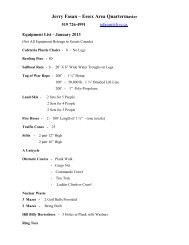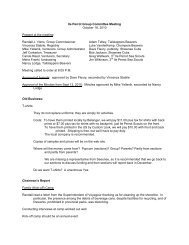Beaver Leader's Handbook - Scouts Canada
Beaver Leader's Handbook - Scouts Canada
Beaver Leader's Handbook - Scouts Canada
You also want an ePaper? Increase the reach of your titles
YUMPU automatically turns print PDFs into web optimized ePapers that Google loves.
The children ultimately set your program time schedule. When a story is too long, <strong>Beaver</strong>s<br />
begin showing signs that it should end. Your adult sense of routine may say the story must<br />
be finished, but you need to learn to leave your routine when<br />
you notice early warning signs that <strong>Beaver</strong>s are restless.<br />
Wiggling, staring into space, or fidgeting<br />
with a neighbour are cues to move on to<br />
the next activity.<br />
Be flexible in your programming to accommodate<br />
the children’s needs. It’s a good idea<br />
to have handy an extra game or song to fill<br />
unexpected gaps of time left when an original<br />
activity doesn’t go as expected.<br />
As a leadership team, discuss ways you can communicate<br />
better to improve shared leadership.<br />
Cooperation (e.g. leaving things in good condition for<br />
the next leader) helps build team spirit and confidence.<br />
Encouragement, and positive words and actions sends a strong<br />
message to your <strong>Beaver</strong>s. Treat your <strong>Beaver</strong>s with respect, and<br />
praise them; both the group and individuals who are succeeding<br />
well. By highlighting examples of good behavior, this reinforces what you expect.<br />
HANDLING DISRUPTIONS<br />
6-6<br />
If your team finds a program item meets with disruptive behaviour, change the pace. You can<br />
break into lodges to talk about the matter, restate the rules, change to a different activity, or stop<br />
the proceeding and tell the colony how you feel about what is happening. Keep rules and instructions<br />
short but clear.<br />
Yelling, unpleasant for you and the <strong>Beaver</strong>s, is generally ineffective and unproductive. Instead,<br />
catch attention with the <strong>Beaver</strong> sign, and wait for silence. Sometimes a <strong>Beaver</strong> simply does not<br />
want to conform. When you face inappropriate behaviour, use warnings sparingly, make sure<br />
they’re a logical consequence to the behaviour, and always follow through.<br />
Never embarrass or humiliate a <strong>Beaver</strong>, especially in front of the colony. Quietly take the child<br />
aside to a public area and discuss the problem. A short time out from activities is not so much a<br />
punishment as an opportunity for both <strong>Beaver</strong> and leaders to collect their emotions and make a<br />
fresh start.<br />
Follow time-outs with encouragement. Let erring <strong>Beaver</strong>s know that you only disapprove of the<br />
behaviour; you still care about them.<br />
In cases of serious or repeated misbehaviour, talk over the problem with both the child and parent<br />
or guardian. The leadership team may also wish to consult the group committee or Service<br />
Scouter for other options.<br />
Don’t be afraid to put one hand up in the air, form your fingers into the <strong>Beaver</strong> sign, and say<br />
loud enough for <strong>Beaver</strong>s to hear, "<strong>Beaver</strong>s, I have my hand up". You can start by making a game<br />
of this early in the year similar to musical chairs. Allow them to dance or run around a little then<br />
put your hand up; they want to look for the hand signal to “STOP, LOOK, and LISTEN". When<br />
you notice that your colony is starting to get rambunctious grab their attention with the <strong>Beaver</strong>








